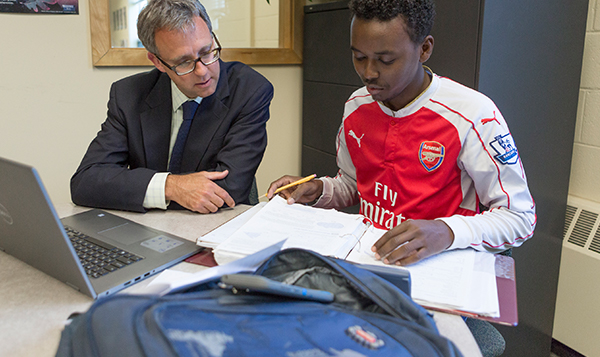The high school years are the perfect time to begin preparing for what comes next, be it a job or higher education. Remember, higher education is any education beyond high school. This includes trade schools and community colleges, as well as public and private colleges and universities. Different schools offer different programs and award different types of degrees.
Find the Right School for You
It’s important to take the time to find the right school for you – geographically, academically, socially, and financially! Consider the topics below and use these tools to find schools that might be a good fit.
Types of Schools
- Career and trade schools generally offer certificate programs.
- Community colleges offer certificate and associate degree programs.
- Public and private colleges and universities generally offer associate and bachelor’s degree programs and may also offer master’s and professional degrees.
Taking the opportunity to visit colleges, universities, and trade schools in different locations (simply by driving through the campus or attending an event) is a great way to become familiar with the options available.
Degree Programs
- A certificate program is an undergraduate degree program that is one year or less of full-time, directed study. Certificate programs can be pursued independently or in addition to an associate or bachelor’s degree to enhance skills or expertise in a specific area.
- An associate degree is an undergraduate degree program that is two years of full-time study.
- A bachelor’s degree is an undergraduate degree program that is four years of full-time study.
- Master’s and professional degrees are graduate degree programs that are typically two to four years of full-time study after completion of a bachelor’s degree.
Saving for College
For most families, financial aid doesn’t cover the full cost of education. Having savings available can make a big difference and has little or no impact on financial aid eligibility.
Reduce Education Debt by Saving
Saving for higher education may help reduce the need to borrow. Students and families who have college savings are always in a better position when it comes to paying for college. Remember, every dollar available from savings is a dollar that doesn’t have to be borrowed and repaid later with interest.
Ask Family to Help Save
Saving for higher education doesn’t have to be all on the shoulders of parents. Encourage grandparents and even aunts and uncles to make gift contributions to your student’s college savings account. Once your high schooler starts working, they can start saving their earnings too.
Ways to Save
Section 529 Plans
Section 529 plans are tax-advantaged investment plans available through most states to help students and families prepare for college expenses. Maine residents may qualify for matching grants from Maine’s Section 529 plan to help them along with their college investing. You also can encourage family and friends to give the gift of education by making contributions to your student’s NextGen 529 account.
Traditional and Roth IRA Withdrawals
Early IRA (Individual Retirement Account) withdrawals, before age 59½, are allowed without the 10% early withdrawal penalty if funds are used for qualified education expenses. These withdrawals may still be taxed as ordinary income.
Planning for Higher Education
There are things you can do each year to prepare for education after high school. Starting freshman year and continuing through senior year, here are some actions you can take to get ready.
Freshman and Sophomore Years
Have the chat about paying for school
It’s a difficult conversation to have, but families who have an early discussion to clarify who is paying for what and how much the family can afford will find the final school selection process easier.
Family financial fitness
Families who start thinking about how to pay for higher education when their student starts high school have more options. Start by paying down debt and resisting the urge to take on new expenses. This helps make room in the monthly budget for a tuition payment plan. Families who take a piecemeal approach, which can include financial aid, savings, tuition payment plans, merit aid, student summer earnings, and scholarships, find paying for higher education more manageable.
Continue exploring career and pathway options
- Research in-demand jobs in Maine and the schooling needed to do those jobs.
- Explore your interests or hobbies, and how they might relate to a career. Learn more about potential careers and what you might need for education or training.
- Considering a skill or trade? Consider programs available at your local Career and Technical Education center.
Junior Year
Learn about the financial aid process
Financial Aid Information Sessions are held in person at many high schools as well as virtually. Ask your school counselor when a presentation will be held at your school. Don’t wait until senior year to attend. The more you learn now, the easier it will be when you are a senior and need to apply for financial aid. Download and read FAME’s publication PAY: Tips to Afford Higher Education for detailed information about paying for higher education.
Research schools
Research schools with a focus not only on major and location, but also affordability. When researching for schools, focus on net price, not sticker price. To get a sense of net price, use each school’s Net Price Calculator which can usually be found on the financial aid section of each school’s website. Start putting together a tentative list of schools to apply to senior year.
Here are two helpful tools you can use to research different schools:
- The College Board’s Big Future
- The U.S. Department of Education’s College Navigator
Start searching for scholarships
Though you won’t typically apply for scholarships until your senior year, you can start searching for scholarships much earlier. Having a list of potential scholarships (and the related application requirements) ready to go early in your senior year will make the application process easier.
Attend college fairs
Talking with representatives from the colleges you are interested in attending can help you decide if you want to pursue that college further. You might also learn about some schools that weren’t on your radar.
New England Board of Higher Education (NEBHE)
Some state universities in New England offer reduced tuition to Maine students pursuing a program that is not offered in Maine. For more information on reduced tuition at an out-of-state school, visit the New England Board of Higher Education’s website.
Take any required tests
Be sure to understand what each of the colleges you are interested in require for standardized tests. Not only may certain tests be required for admission, but some colleges also use these tests to determine eligibility for merit scholarships. Check with your school counselor for registration information and testing dates.
Research careers
What would you like to do? Research different jobs and learn what type of education you’ll need to achieve your career goals.
- Maine Career Center – Explore careers, training and jobs in Maine.
- Career One Stop – Explore careers, training and jobs throughout the United States.
- FAME Student Loan/Salary Calculator – Make informed student loan borrowing decisions.
Senior Year
Build a list of schools
Build a list of schools, including schools that appear to be affordable. Many factors determine which schools might be a good fit. But too often, affordability isn’t considered until late in the process. When searching for schools, focus on net price, not sticker price. Make sure that your list includes a school that is affordable even without great financial aid. For some students, community college and/or trade-based certificate programs are a good option.
Apply for admission
Most admission applications are on each college’s website and can be submitted electronically. Many schools also accept the Common Application. Keep track of deadlines. Learn about admissions options, such as Early Decision or Early Action.
Apply for financial aid
Make sure you are ready to apply for financial aid by knowing what the required forms and deadlines are for the colleges that interest you. Track required forms and deadlines. All students should file a FAFSA as soon as possible after October 1 of their senior year. Be sure you understand what happens after you file the FAFSA, and follow up as necessary. Have questions? Attend a FAME FAFSA Help Session.
Compare financial aid offers
Financial aid offers all look different, making them hard to compare. To help get an “apples-to-apples” comparison, families can use FAME’s Comparing Costs and Financial Aid Offers Worksheet. If borrowing is needed, families should use FAME’sStudent Loan/Salary Calculator to get a better understanding of the return on investment.
Research graduation rate and job placement
Before making a final decision about school selection, research the graduation rate and job placement statistics of colleges you’re interested in attending. Higher graduation and job placement rates often signify a school with a strong professional network and successful internship or job placement programs.
Financial wellness
No matter where you are in life, it’s never too early or too late to establish sound money management practices. Learn more about setting financial goals, creating a budget, saving and investing, and credit-related topics by visiting FAME’s Financial Wellness page.
SUMMER EMAIL SERIES
Class of 2025: Your Guide to Affording Higher Education
Higher education can be affordable. Our nine-week summer email series is a step-by-step guide on ways to make paying for your higher education more manageable. Sign up to receive the Class of 2025 summer email series, and we’ll also send you helpful tips and timely reminders throughout your senior year to help you stay on track!
- Week 1: The Piecemeal Approach to Paying for Higher Education
- Week 2: Summer Jobs and Savings
- Week 3: Scholarships
- Week 4: The Financial Aid Process
- Week 5: Applying for Need-Based Financial Aid
- Week 6: How Schools Determine Financial Aid Eligibility
- Week 7: How to Find Schools with the Best Financial Aid
- Week 8: Net Price: How to Estimate What a School Will Cost You
- Week 9: The Final Piece in the Piecemeal Approach




